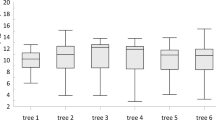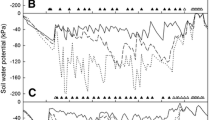Summary
Different proportions of the soil volume of ‘Shamouti’ orange (Citrus sinensis L. Osbeck) trees were irrigated at similar levels of available water during 1979 to 1981 in the coastal plain of Israel. Two treatments were compared: one in which 100% of the soil volume was irrigated (fully irrigated plot), and the other in which 40% of the volume was irrigated (partially irrigated plot) by sprinklers and sprayers, respectively. Irrigations were given independently in the two treatments whenever the moisture content in the wetted soil dropped to a fixed predetermined level (Table 2). Moisture depletion was measured by the neutron scattering method, transpiration by the heat pulse method and soil evaporation by microlysimeters. Averaged for the three years, water depletion from the partially irrigated plot was 66% of that of the fully irrigated one (Table 1). Transpiration in 1980 from trees of the partially irrigated plot was 72% of the transpiration from trees of the fully irrigated plot (Fig. 3 and Table 6), and the evaporation from the soil surface was 58% (Fig. 4). The density of roots less than 1 mm in diameter in the dry soil region of the partially irrigated plot was 45% of the equivalent region of that in the fully irrigated plot. Underneath the tree row (the wetted region) the root density ratio was 77% (Fig. 2). Extraction of stored water from the unirrigated soil volume of the partially irrigated plot ceased in July (Fig. 1). Transpiration from the partially irrigated plot recovered during the spring period following the rainy winter season (Table 7). The total production of flowers per tree was 120,000 in the partially irrigated plot during 1981, as compared with 79,000 per tree in the fully irrigated plot (Table 3). There was a considerable difference in flower abscission between treatments especially at the beginning of the flowering season. The flower abscission rate in the partially irrigated trees was higher than in the fully irrigated trees (Fig. 5). In contrast, abscission of fruitlets was less in the partially irrigated treatment (Fig. 5).
Similar content being viewed by others
References
Ben-Asher J, Sammis TW (1978) Radiation and energy balance of a trickle-irrigated lemon grove. Agron J 70:568
Bialoglowsky J (1936) Effect of extent and temperature of roots on transpiration of rooted lemon cuttings. Proc Am Soc Hort Sci 34:96
Bielorai H (1977) The effect of drip and sprinkler irrigation on grapefruit yield, water use and soil salinity. In: Proc. Int Soc Citriculture 1: 99
Bielorai H (1982) The effect of partial wetting of the root zone on yield and water use efficiency in a drip and sprinkler-irrigated mature grapefruit grove. Irrig Sci 3:89
Bielorai H, Dasberg S, Erner Y, Brum M (in press) The effect of various soil moisture regimes and fertilizer levels on citrus yield response under partial wetting of the root zone. 1981 International Citrus Congress Tokyo Japan
Cohen Y, Fuchs M, Green GC (1981) Improvement of the heat pulse method for determining sap flow in trees. Plant Cell Environ 4:391
Erickson LC (1968) The general physiology of citrus. In: Reuther W, Batchelor LD, Webber HJ (eds) The Citrus Industry. Univ of California, Div of Agric Sci, Berkeley, CA Vol 2, Chap 2, pp 54–63
Furr JR, Taylor CA (1939) Growth of lemon fruits in relation to moisture content of the soil. Tech Bull US Dept Agric 640
Heller J, Shalhevet J, Goell A (1973) Response of a citrus orchard to soil moisture and soil salinity. In: Hadas A, Swartzendruber D, Rijtema PE, Fuchs M, Yaron B (eds) Physical aspects of soil water and salts in ecosystems. Ecological Studies. Analysis and Synthesis Springer-Verlag, Berlin Heidelberg New York, Vol 4, pp 409–419
Hilgeman RH (1973) Irrigation of “Valencia” orange trees by wetting alternate sides. In: Carpena O (ed) International Citrus Congress Madrid, Spain. Vol I, pp 265–269
Hilgeman RH (1977) Response of citrus trees to water stress in Arizona. Proc Int Soc Citriculture 1:70
Huberty MR, Richards JJ (1954) Higher yields obtained with frequent irrigation. Calif Citrograph 39:408
Mantell A (1977) Water use efficiency of citrus: Room for improvement? Proc Int Soc Citriculture 1:74
Moreshet S, Fuchs M, Cohen Y (1981) The water requirement of citrus trees under partial irrigation conditions. Alon Hanotea 35:617 (Hebrew)
Reginato RJ, van Bavel CHM (1962) Pressure cell for soil cores. Proc Soil Sci Soc Am 26:1
Rosene HF (1955) The water absorptive capacity of winter rye root hairs. New Phytol 54:95
Shalhevet J, Mantell A, Bielorai H, Shimshi D (eds) (1976) Irrigation of Field and Orchard Crops under Semi-arid Conditions. Int Irrigation Information Center, Bet Dagan Publ No 1, 110 p.
Stolzy LH, Taylor OC, Garber MJ, Lombard PB (1963) Previous irrigation treatments as factors in subsequent irrigation level studies in orange production. Proc Am Soc Hort Sci 82:199
Author information
Authors and Affiliations
Additional information
Contribution from the Agricultural Research Organization, The Volcani Center, Bet Dagan, Israel. No. 467-E, 1982 series
Rights and permissions
About this article
Cite this article
Moreshet, S., Cohen, Y. & Fuchs, M. Response of mature ‘Shamouti’ orange trees to irrigation of different soil volumes at similar levels of available water. Irrig Sci 3, 223–236 (1983). https://doi.org/10.1007/BF00272838
Received:
Issue Date:
DOI: https://doi.org/10.1007/BF00272838




